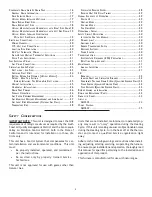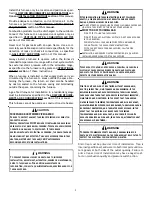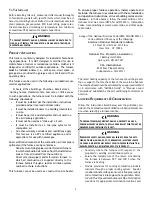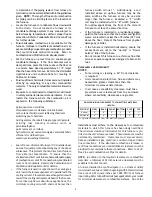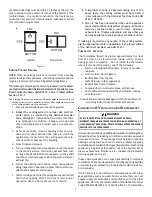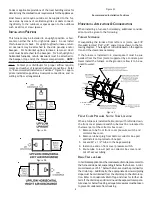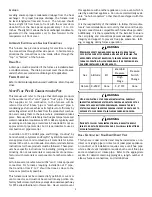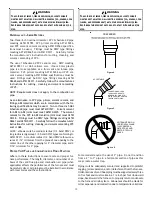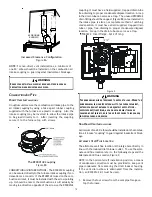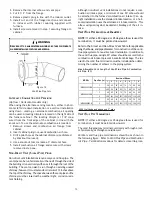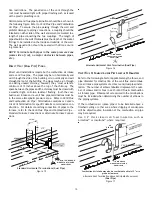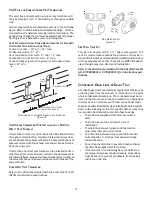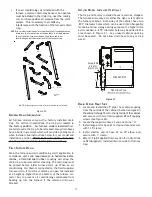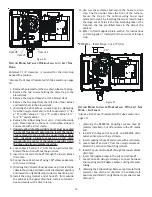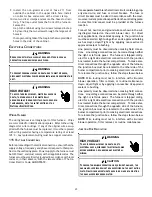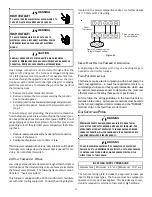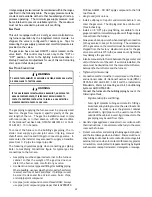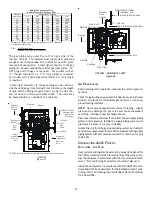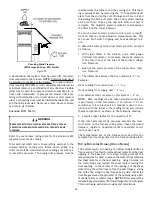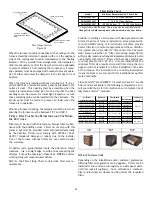
11
For this reason, particular care must be taken to secure pip-
ing when a long run is followed by a short offset of less than
40 inches.
Precautions should be taken to prevent condensate from freez-
ing inside the vent/flue pipe and/or at the vent/flue pipe termi-
nation. All vent/flue piping exposed to freezing temperatures
below 35°F for extended periods of time must be insulated with
1/2” thick closed cell foam. Also all vent/flue piping exposed
outdoors in excess of the terminations shown in this manual
(or in unheated areas) must be insulated with 1/2” thick
closed cell foam. Inspect piping for leaks prior to installing
insulation.
T
ERMINATION
L
OCATIONS
NOTE:
Refer to
Location Requirements and Considerations
for
combustion air contaminant restrictions.
12"
Non-Direct Vent
Vent/Flue Termination
No Terminations
Above Walkway
12"
min.
4'
min.
Non-Direct Vent
Vent/Flue Termination
Direct Vent
Vent/Flue Termination
<10'
Forced Air
Inlet
Non-Direct Vent
&
Direct Vent
Vent/Flue Terminations
Grade or Highest
Anticipated
Snow Level
3' min.
12" min.
4' min.
12" min.
Vent Termination Clearances
Figure 7
The following bullets and diagram describe the restrictions con-
cerning the appropriate location of vent/flue pipe and combus-
tion air intake pipe (when applicable) terminations. Refer to
Non-Direct Vent (Single Pipe) Piping
and
Direct Vent (Dual Pipe)
Piping
located in this section for specific details on termination
construction.
•
All terminations (flue and/or intake) must be located
at least 12 inches above ground level or the anticipated
snow level.
•
Vent terminations (non-direct and direct vent) must
terminate at least 3 feet above any forced air inlet
located within 10 feet.
NOTE:
This provision does not apply to the combustion
air intake termination of a direct vent application.
•
The vent termination of a
non-direct
vent
application must
terminate at least 4 feet below, 4 feet horizontally from,
or 1 foot above any door, window, or gravity air inlet
into any building.
•
The vent termination of a
direct vent
application must
terminate at least 12 inches from any opening through
which flue gases may enter a building (door, window, or
gravity air inlet).
•
The vent termination of vent pipe run vertically through a
roof must terminate at least 12 inches above the roof line
(or the anticipated snow level) and be at least 12 inches
from any vertical wall (including any anticipated snow
build up).
•
A vent termination shall not terminate over public
walkways
or over an area where condensate or vapor could create
a nuisance or hazard or could be detrimental to the
operation of regulators, relief valves, or other
equipment.
•
The combustion air intake termination of a direct vent
application should not terminate in an area which is
frequently dusty or dirty.
S
TANDARD
F
URNACE
C
ONNECTIONS
It is the responsibility of the installer to ensure that the pip-
ing connections to the furnace are secure, airtight, and ad-
equately supported.
Vent/Flue Pipe
The vent pipe outlet is sized to accept 2” pipe. Secure
vent/flue pipe directly into the furnace fitting with the
appropriate glue. Alternately, a small section of 2" pipe
may be glued in the furnace socket and a rubber coupling
installed to allow removal for future service. Combustion
Air and Vent piping should be routed in a manner to avoid
contact with refrigerant lines, metering devices, conden-
sate drain lines, etc. If necessary, clearances may be in-
creased by creating an offset using two 45 degree elbows.
This joint can be rotated on the fitting to establish maxi-
mum clearance between refrigerant lines, metering de-
vices, and condensate drain lines, etc. This joint is the
equivalent of one 90 deg. elbow when considering elbow
count. (Figure 8A)


